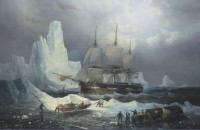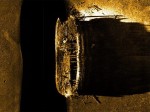 April in the High Arctic does not involve showers bringing flowers. It still the dead of winter up there, the water frozen over with ice more than six feet thick. When the Parks Canada-led underwater exploration of the Victoria Strait in search of the two ships from Sir John Franklin’s doomed 1845 voyage to find the fabled northwest passage discovered the wreck of the HMS Erebus last year, it was the first week in September. The 2014 Victoria Strait Expedition began in mid-August. They found the wreck three weeks later using side-scan sonar and a remotely operated underwater vehicle. After that they only had two days to dive to the wreck before storms came in, the temperatures dropped below freezing and the summer diving season came to an abrupt end.
April in the High Arctic does not involve showers bringing flowers. It still the dead of winter up there, the water frozen over with ice more than six feet thick. When the Parks Canada-led underwater exploration of the Victoria Strait in search of the two ships from Sir John Franklin’s doomed 1845 voyage to find the fabled northwest passage discovered the wreck of the HMS Erebus last year, it was the first week in September. The 2014 Victoria Strait Expedition began in mid-August. They found the wreck three weeks later using side-scan sonar and a remotely operated underwater vehicle. After that they only had two days to dive to the wreck before storms came in, the temperatures dropped below freezing and the summer diving season came to an abrupt end.
 Now that the Erebus has been found, this year’s expedition will be able to focus on diving the wreck site, but that tiny window of less than a month of above-freezing temperatures can’t quench the Canadian government’s thirst to explore the shipwreck. Researchers want to get back to the Erebus as soon as possible to explore it more thoroughly before artifacts are damaged by the elements or any putative looters with Bond-villain levels of equipage. Canada’s government and military want to get the show on the road “to assert Canada’s sovereignty over its northernmost regions, demonstrate the ability to operate in the harsh environment in remote areas of the High Arctic, and enhance its capability to respond to any situation in Canada’s North.” That’s a quote from Prime Minister Stephen Harper’s press release announcing that this year the diving will begin in April.
Now that the Erebus has been found, this year’s expedition will be able to focus on diving the wreck site, but that tiny window of less than a month of above-freezing temperatures can’t quench the Canadian government’s thirst to explore the shipwreck. Researchers want to get back to the Erebus as soon as possible to explore it more thoroughly before artifacts are damaged by the elements or any putative looters with Bond-villain levels of equipage. Canada’s government and military want to get the show on the road “to assert Canada’s sovereignty over its northernmost regions, demonstrate the ability to operate in the harsh environment in remote areas of the High Arctic, and enhance its capability to respond to any situation in Canada’s North.” That’s a quote from Prime Minister Stephen Harper’s press release announcing that this year the diving will begin in April.
 Winter dives are, it goes without saying, hugely dangerous. They require heavy equipment to cut through the ice sheet, specialized diving gear including an umbilical to provide air and communication lines, extensive supplies, emergency medical services and lots and lots of training. It’s not something Parks Canada’s underwater archaeologists can handle on their own, so for nine weeks they’ve been working with expert ice divers from the Royal Canadian Navy’s Fleet Diving Unit Atlantic. Parks Canada divers and the Navy divers have been training together so that the former can learn how to dive safely in below-freezing water under a sheet of ice that’s at least six feet thick (a terrifying practice known as confined space diving) and the latter can learn how to properly handle an underwater archaeological site and its artifacts.
Winter dives are, it goes without saying, hugely dangerous. They require heavy equipment to cut through the ice sheet, specialized diving gear including an umbilical to provide air and communication lines, extensive supplies, emergency medical services and lots and lots of training. It’s not something Parks Canada’s underwater archaeologists can handle on their own, so for nine weeks they’ve been working with expert ice divers from the Royal Canadian Navy’s Fleet Diving Unit Atlantic. Parks Canada divers and the Navy divers have been training together so that the former can learn how to dive safely in below-freezing water under a sheet of ice that’s at least six feet thick (a terrifying practice known as confined space diving) and the latter can learn how to properly handle an underwater archaeological site and its artifacts.
 The logistics are daunting, to say the least. The Navy will establish a divers’ camp on the sea ice in eastern Queen Maud Gulf where more than 50 people will live for the 11 days of the expedition. Those people all have to be fed, housed, fueled and heated. Inuit Rangers will be on the team to handle wayward polar bears and help the camp survive any frigid gales from the North Pole that might assault it. Once the divers’ ice camp is set up, three triangular dive holes with sides two meters (6’7″) long will be made in the ice sheet with a gas-fired hot water drill. Each hole is expected to take five hours to cut and the blocks of ice they cut out will weigh something in the neighborhood of four tons. Heavy equipment will be needed to haul the ice chunks out of the water.
The logistics are daunting, to say the least. The Navy will establish a divers’ camp on the sea ice in eastern Queen Maud Gulf where more than 50 people will live for the 11 days of the expedition. Those people all have to be fed, housed, fueled and heated. Inuit Rangers will be on the team to handle wayward polar bears and help the camp survive any frigid gales from the North Pole that might assault it. Once the divers’ ice camp is set up, three triangular dive holes with sides two meters (6’7″) long will be made in the ice sheet with a gas-fired hot water drill. Each hole is expected to take five hours to cut and the blocks of ice they cut out will weigh something in the neighborhood of four tons. Heavy equipment will be needed to haul the ice chunks out of the water.
About two dozen team members will be divers who will go down the hole to explore the wreck site in pairs — one underwater archaeologist, one Navy diver — in shifts over a 12-hour workday. The tasks they will perform include trimming the kelp bed that is obscuring the view of the ship, testing a new laser device that makes 3D scans of the interior of the hull and film/photograph inside the hull with cameras affixed to a pole. Mapping and documenting the wreck is the primary focus, but the team will also come prepared to recover any artifacts they think should be recovered. They won’t be wearing specialized hot water-warmed suits; they’ll be protected from frozen death by thermal underwear, cotton gloves and triple-layered dry suits. In those kinds of temperatures the fingers get creaky very quickly, but if you pile on the layers you can’t use your hands. The solution is short shifts just 50 minutes long. That’s why there are so many divers on the team, to man 12 or so dives a day.
All of this is conditions permitting, of course. Storms over the ice sheet can be brutal and could grind operations to a halt. The thick ice actually seals the sea underneath it keeping it relatively calm in a storm, so divers would actually find good conditions and visibility even in violently unpleasant surface conditions, but obviously their lives are dependent on base operations being uninterrupted so if the weather gets too severe the dives will have to stop.
To learn more about the team members, their training and to follow their adventures on the 2015 Franklin Expedition, check out this Parks Canada site. The Dive Diary is particularly bookmarkworthy.